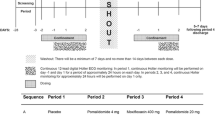Abstract
Background and Objective: Prulifloxacin, a broad-spectrum fluoroquinolone, is quantitatively transformed after oral administration into ulifloxacin, the active metabolite. On the basis of preclinical data suggesting that prulifloxacin is not likely to prolong the QT interval, a trial to assess the potential effects of prulifloxacin on QT and corrected QT (QTc) interval in humans was performed.
Methods: Fifty-two healthy subjects were randomized into three groups to receive prulifloxacin 600 mg, moxifloxacin 400 mg and placebo once daily for 5 days, using a crossover, double-blind versus placebo, moxifloxacin-controlled study. At baseline and days 1 and 5, three 12-lead digital ECGs were recorded before and up to 24 hours after dosing at nine predefined timepoints. Blood samples were also collected at each treatment timepoint. ECG data were analysed in a blinded manner by a centralized laboratory using skilled readers. QT values were corrected for heart rate using an individual correction method (QTcI) as the primary variable, and Fridericia’s method as reference.
Results: In forty-eight subjects who completed the study, compared with placebo, prulifloxacin had no relevant effect on cardiac repolarization, with the largest mean QTcI increase being 3.97 ms (one-sided 95% CI 0.01, 7.93), whereas moxifloxacin demonstrated the expected positive effect (maximum mean QTcI increase of 12.0 ms, one-sided 95% CI 8.66, 15.34), thus demonstrating the good sensitivity of the study. A statistically significant correlation between QTcI changes and plasma concentrations was found for moxifloxacin but not for ulifloxacin.
Conclusion: Prulifloxacin at steady state after therapeutic doses has no significant effects on the QTc interval and thus should prove to have no cardiac liability.





Similar content being viewed by others
References
Shah RR. Drug-induced prolongation of the QT interval: why the regulatory concern? Fundam Clin Pharmacol 2002; 16(2): 119–24
Morganroth J. Cardiac repolarization and the safety of new drugs defined by electrocardiography. Clin Pharmacol Ther 2007; 81(1): 108–13
Sager PT. Key clinical considerations for demonstrating the utility of preclinical models to predict clinical drug-induced torsades de pointes. Br J Pharmacol 2008; 154(7): 1544–9
Shah RR. Drugs, QTc interval prolongation and final ICH E14 guideline: an important milestone with challenges ahead. Drug Saf 2005; 28(11): 1009–28
Mehlhorn AJ, Brown DA. Safety concerns with fluoroquinolones. Ann Pharmacother 2007; 41: 1859–66
Kang J, Wang L, Chen XL, et al. Interactions of a series of fluoroquinolone antibacterial drugs with the human cardiac K+ channel HERG. Mol Pharmacol 2001; 59(1): 122–6
Keam SJ, Perry CM. Prulifloxacin. Drugs 2004; 64(19): 2221–34
Cazzola M, Salvatori E, Dionisio P, et al. Prulifloxacin: a new fluoroquinolone for the treatment of acute exacerbation of chronic bronchitis. Pulm Pharmacol Ther 2006; 19Suppl. 1: 30–7
Carmignani G, De Rose AF, Olivieri L, et al. Prulifloxacin versus ciprofloxacin in the treatment of adults with complicated urinary tract infections. Urol Int 2005; 74(4): 326–31
Roveta S, Schito AM, Marchese A, et al. Microbiological rationale for the utilisation of prulifloxacin, a new fluoroquinolone, in the eradication of serious infections caused by Pseudomonas aeruginosa. Int J Antimicrob Agents 2005; 26(5): 366–72
Tougou K, Nakamura A, Watanabe S, et al. Paraxonase has a major role in the hydrolysis of prulifloxacin (NM441), a prodrug of a new antibacterial agent. Drug Metab Dispos 1998; 26(4): 355–9
Picollo R, Brion N, Gualano V, et al. Pharmacokinetics and tolerability of prulifloxacin after single oral administration. Arzneimittelforschung 2003; 53(3): 201–5
Lacroix P, Crumb WJ, Durando L, et al. Prulifloxacin: in vitro (HERG current) and in vivo (conscious dog) assessment of cardiac risk. Eur J Pharmacol 2003 Sep 5; 477(1): 69–72
Akita M, Shibazaki Y, Izumi M, et al. Comparative assessment of prulifloxacin, sparfloxacin, gatifloxacin and levofloxacin in the rabbit model of proarrhythmia. J Toxicol Sci 2004; 29(1): 63–71
Data on file, ACRAF SpA, Rome, 2009
Malik M, Camm AJ. Evaluation of drug-induced QT interval prolongation: implications for drug approval and labelling. Drug Saf 2001; 24(5): 323–51
Committee for Medicinal Products for Human Use (ICH Topic E14). Note for guidance on the clinical evaluation of QT/QTc interval prolongation and proarrhythmic potential for non-antiarrhythmic drugs. CHMP/ICH/2/04 London, 25 May 2005
Committee for Medicinal Products for Human Use (ICH Topic E14). The clinical evaluation of QT/QTc interval prolongation and proarrhythmic potential for non-antiarrhythmic drugs: questions and answers. EMEA/CHMP/ICH/310133/ 2008 June 2008
Tsikouris JP, Peeters MJ, Cox CD, et al. Effects of three fluoroquinolones on QT analysis after standard treatment courses. Ann Noninvasive Electrocardiol 2006; 11(1): 52–6
Padrini R, Gusella M, Al Bunni M, et al. Tolerance to the repolarization effects of rac-sotalol during long-term treatment. Br J Clin Pharmacol 1997; 44(5): 463–70
Kubitza D, Mueck W, Becka M. Randomized, double-blind, crossover study to investigate the effect of rivaroxaban on QT-interval prolongation. Drug Saf 2008; 31(1): 67–77
Acknowledgements
This work was supported by a grant from Angelini Pharmaceuticals, ACRAF SpA, Rome, Italy. The authors are employees of Angelini Pharmaceuticals. The authors would like to thank Dr Joel Morganroth for his invaluable editorial assistance.
Author information
Authors and Affiliations
Corresponding author
Rights and permissions
About this article
Cite this article
Rosignoli, M.T., Di Loreto, G. & Dionisio, P. Effects of Prulifloxacin on Cardiac Repolarization in Healthy Subjects. Clin. Drug Investig. 30, 5–14 (2010). https://doi.org/10.2165/11319400-000000000-00000
Published:
Issue Date:
DOI: https://doi.org/10.2165/11319400-000000000-00000




